Economics HL 2.4, 2.7, 2.8
2.4 - Behavioural Economics
Assumptions of Rational Consumer Choice
free markets are built on the assumptions of rational decision making
in classical economic theory, rational means economics agents are able to consider the outcome of their choices and recognise the net benefits of each one
rational agents - will select the choice that reaps highest benefit/utility
Rational choice theory - individuals use logic and sensible reasons to determine the correct choice (connected to an individual’s self-interest)
Consumer Rationality
assumption that individuals use rational calculations to make choices which are within their own best interest (using all information available to them)
Utility Maximization
economic agents select choices that maximize their utility to the highest level
Perfect Information
information is easily accessible about all goods/services on the market
individuals have access to all information available at all times in order to make the best possible decision
Limitations of Assumptions of Rational Consumer Choice
behavioural economics recognizes that human decision-making is influenced by cognitive biases, emotions, social, and other psychological factors that can lead to deviations from rational behaviour
individuals are unlikely to always make rational decisions
5 limitations are shown below:
Biases
biases influence how we process information when making decisions = influence the process of rational decision making
example: common sense, intuition, emotions, personal/social norms
Types of Bias
Rule of Thumb - individuals make choices based on their default choice gained from experience (ex: same product from same company, but not the best possible choice)
Anchoring and Framing - individuals rely too heavily on an initial piece of information (anchor) when making subsequent judgements or decisions (ex: car dealer says car is worth $10,000 and you know it’s worth less, but this anchor of information causes you to purchase the car for a higher price)
Availability - individuals rely on immediate examples of information that come to mind easily when making judgements/decisions (causes individuals to overestimate the likelihood/importance of events/situations based on how readily available they are in their memory)
Bounded Rationality
people make decisions without gathering all necessary information to make a rational decision within a given time period
rational decision making is limited because of
thinking capacity
availability of information
lack of time available to gather information
too many choices also cause people to make irrational decisions
example: in a supermarket, there are too many choices of products of the same good, making it difficult to reach a decision
Bounded Self-Control
individuals have a limited capcity to regulate their behaviour and make decisions in the face of conflicting desires or impulses
self-control is not an unlimited resource
because humans are influenced by family, friends, or social settings, it causes social norms to interfere in decision making (does not result in the maximization of consumer utility)
decision making based on emotions → does not yield the best outcome
businesses capitalize on the lack of bounded self-control of individuals when appealing to their target audience to maximize sales
Bounded Selfishness
economics agents do not always act within their own self interest
individuals do things for others without a direct reward
ex: altruism - selflessness without expecting anything in return
Imperfect Information
information is not perfectly accessible due to:
intelluctual property rights
cost of accessing information
amount of information and options available
people make decisions based on limited information
asymmetric information may also lead to decisions based on limited information
when one party has more information than another
Choice Architecture
intentional design of how choices are presented so as to influence decision making
simplifies the decision making process
3 types, as shown below:
Default Choice
individual is automatically signed up to a particular choice
decision is already made even when no action has been taken
individuals rarely change from the default change
Restricted Choice
choices available to individuals are limited which helps individuals make more rational decisions
Mandated Choices
requires individuals to make a specific decision or take a particular action by imposing a requirement or obligation
mandated choices can be used to ensure compliance with regulations or societal norms, making it necessary for individuals to make certain decisions
Nudge Theory
practice of influencing choices that economic agents make, using small prompts to influence their behaviour
firms should use nudges in a responsible way to guide and influence decision making
designed to guide people toward certain decisions or actions while still allowing them to have freedom of choice
consumer nudges should be designed with transparancy, respect for individual autonomy, and clear societal benefits in mind
Profit Maximization
most firms have the rational business objectiveof profit maximization
profits benefit shareholders as they receive dividends and also increase the underlying share price
an increase in the underlying share price increases the wealth of the shareholder
profit maximization rule
when MC=MR, then no additional profit can be extracted from producing another unit of output
when MC<MR, additional profit can still be extracted by producing another unit of output
when MC>MR, the firm has gone beyond the profit maximization level of output and starts making a marginal loss on each unit produced (beyond MR=MC)
in reality, firms find it difficult to produce at the profit maximization level of output
the level may be unknown
in the short term, they may not adjust their prices if the marginal cost changes
MC changes regularly and regular price changes would be disruptive
in the long-term, firms will seek to adjust prices to the profit maximization level of output
firms may be forced to change prices by the competition regulators in their country
profit maximization level of output often results in high prices for consumers
changing prices changes the marginal revenue
Growth
increasing sales revenue/market share
maximize revenue to increase output and benefit from economies of scale
a growing firms is less likely to fail
Revenue Maximization as a Sign of Growth
in the short-term, firms may use this strategy to eliminate the competition as the price is lower than when focusing on profit maximization
firms produce up to the level of output where MR=0
when MR>0, producing another unit of output will increase total revenue
Market Share as a Sign of Growth
sales maximzation which further lowers prices and has the potential to increase market share
occurs at the level of output where AC=AR (normal profit/breakeven)
firms may use this strategy to clear stock during a sale to increase market share
firms sell remaining stock without making a loss per unit
Satisficing
pursuit of satisfactory/acceptable outcomes rather than profit maximization
decision-making approaach where businesses aim to meet a minimum threshold or standard of performance rather than striving for the absolute best outcome
small firms may satisfice around the desires of the business owner
many large firms often end up satisficing as a result of the principal agent problem
when one group (the agent) makes decisions on behalf of another group (the Principal), often placing their priorities above the Principal’s
Corporate Social Responsibility (CSR)
conducting business activity in an ethical way and balancing the interests of shareholders with those of the wider community
extra costs are involved in operating in a socially responsible way and these costs must be passed on to consumers
2.7 - Government Intervention
Why do governments intervene in markets?
Influence (increase/decrease) household consumption
provide support to firms
earn revenue
influence the level of production of firms
provide support to low-income households
correct market failure
promote equity
Microeconomic forms of government intervention
price controls
indirect taxes
subsidies
direct provision of services
command and control regulation and legislation
consumer nudges
Price controls
price ceiling + price floor
Price Ceiling
maximum price
below equilibrium point
the point where the price ceiling is set is Pmax
at Pmax, firms are willing to supply Qmax but the consumers demand a quantity above Q*
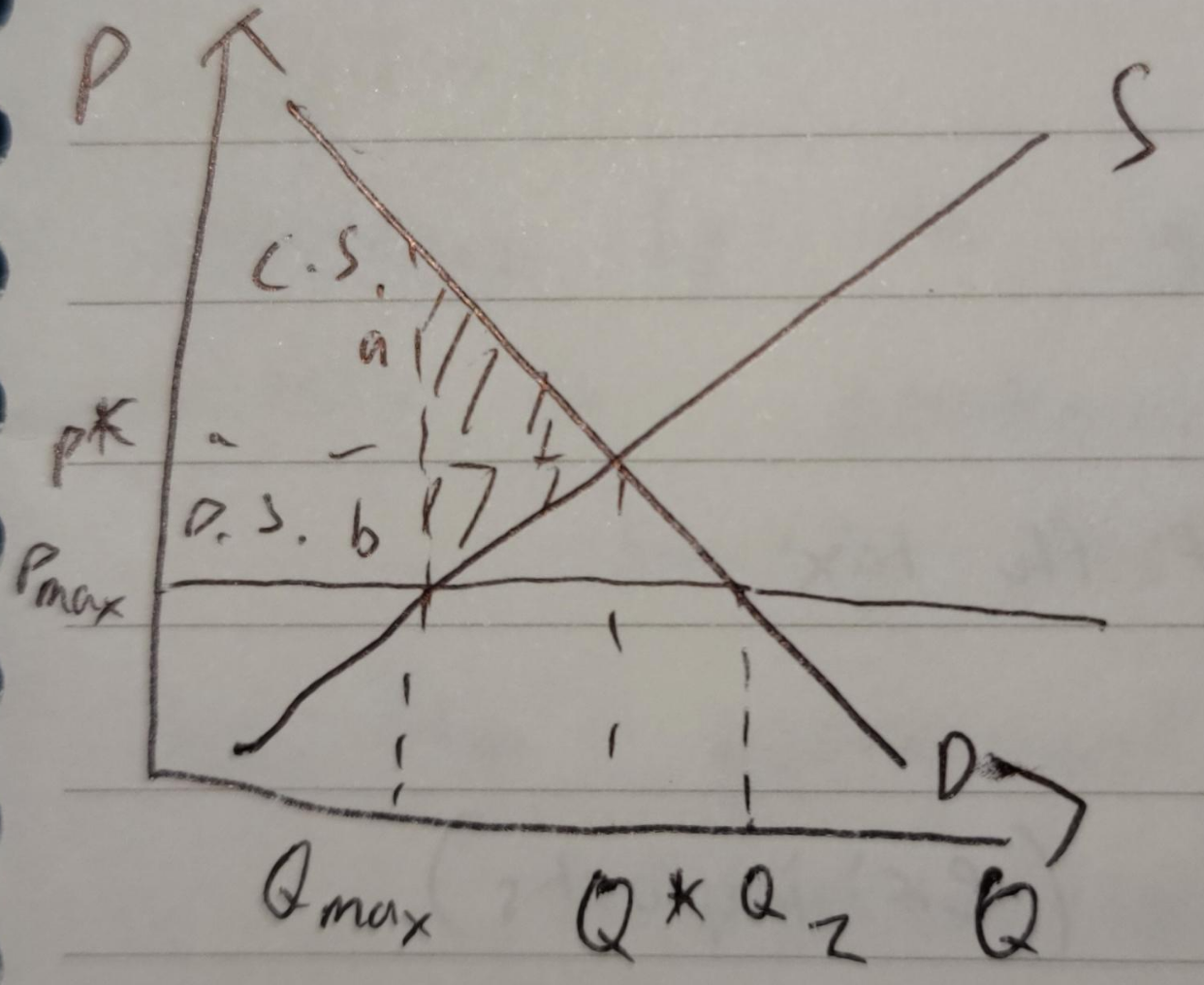
shaded area - 2 triangles, a and b
a = amount by which consumer surplus is reduced
b = amount by which produer surplus is reduced
excess demand shown by the values Qmax - Q1
managed through subsidies and tax breaks → costs
Price Floor
minimum price
above equilibrium point (Pmin)
common in agriculture
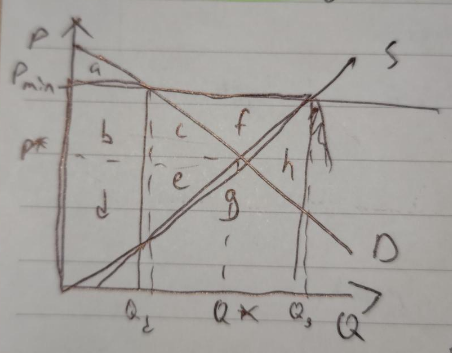
areas c, e, f, g, h are government expenditure → excess supply
producer surplus is increased (d+e → b, c, d, e, f)
f = directly from the government to the producers
a price floor creates welfare loss, indicating allocative inefficiency due to an overallocation of resources to the production of goods
society is getting too much of the good
Indirect taxes
imposed on spending to buy goods and services
both consumers and producers pay a share of the tax
firms practically pay the tax
excise taxes - imposed on particular goods/services (ex: imports)
taxes on spending - value added tax (VAT) or goods/services tax (GST)
direct taxes are those directly paid to the government by taxpayers
an indirect tax creates a tax wedge
consumers face a higher price, while producers receive a lower price
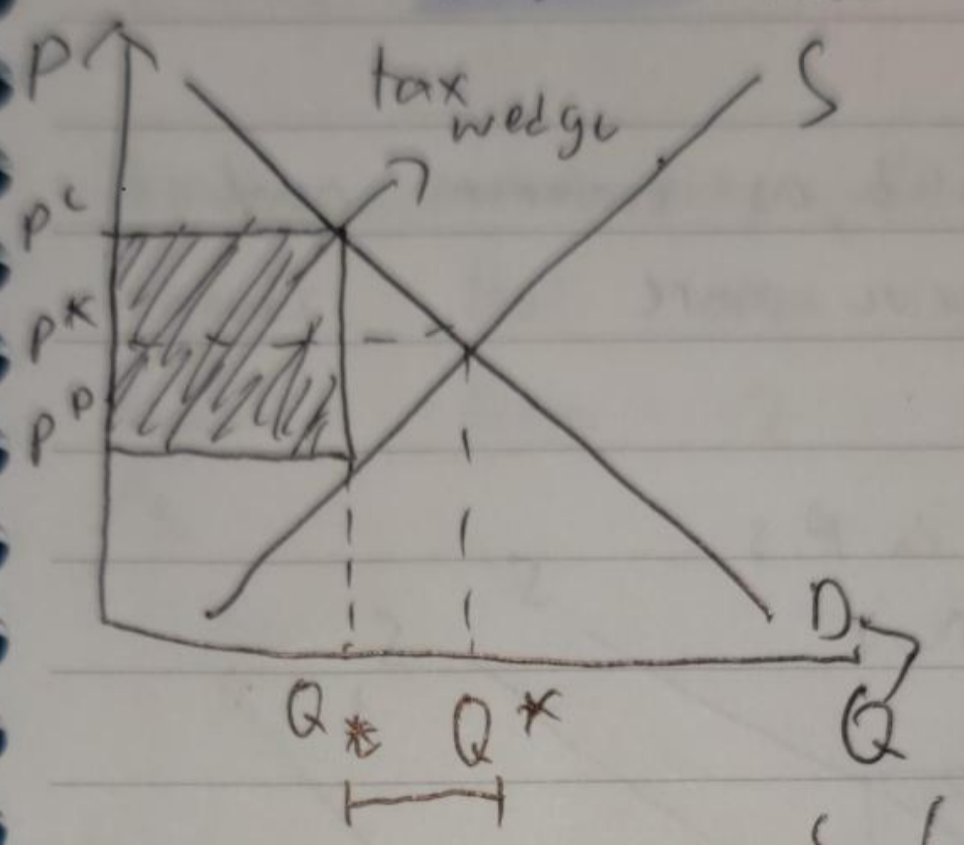
Qt - Q* → lost sales (potential sales but they are lost/didn’t happen because of the tax)
Pp - price for producers, marginal cost
area of rectangle = government revenue
Pc - price for consumers
Pc>Pp, so demand decreases
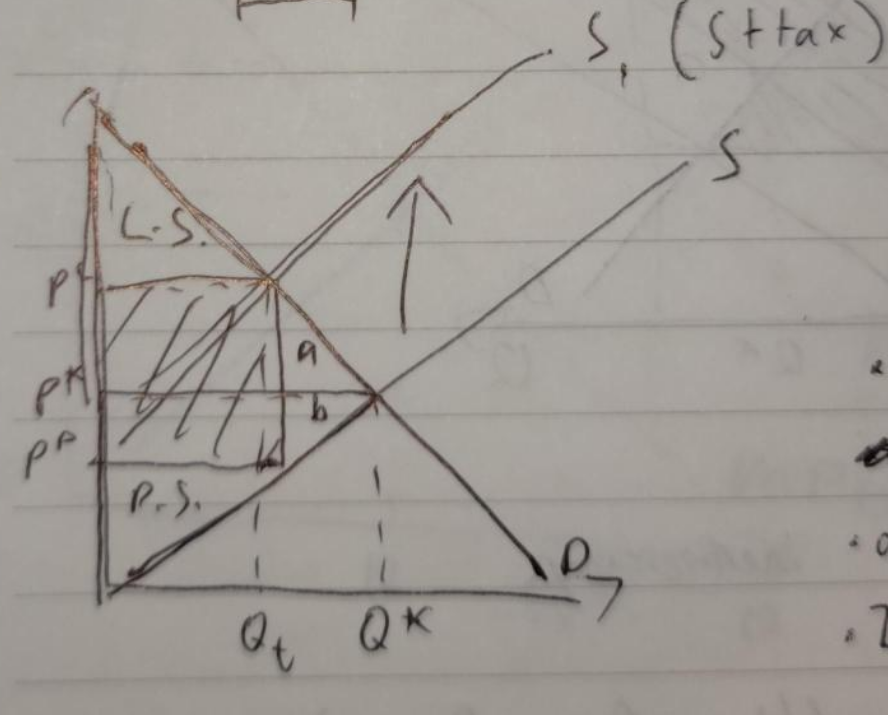
shifts from S → S1
new equilibrium point formed at (Qt, Pc)
2 triangles, a and b
a + b - welfare loss, Dead Weight Loss (DWL)
both disappear, allocative inefficiency
a - consumer surplus loss
b - producer surplus loss
2 prices, C.S. and P.S. at different equilibriums
Subsidies
assistance by the government to individuals (firms, consumers, industries)
results in greater consumer and producer surplus
society loss as government spending on subsidy
loss from government spending is greater than the gain in surplus
welfare loss (allocative inefficiency) due to overallocation of resources to the production of goods (overproduction)
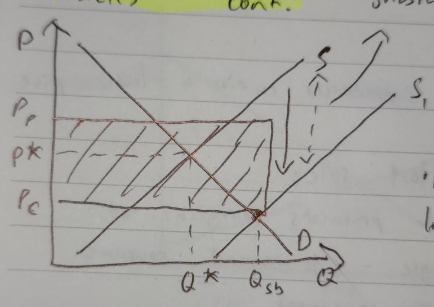
Pp and Pc switched (from indirect taxes), as consumers pay less and producers receive more
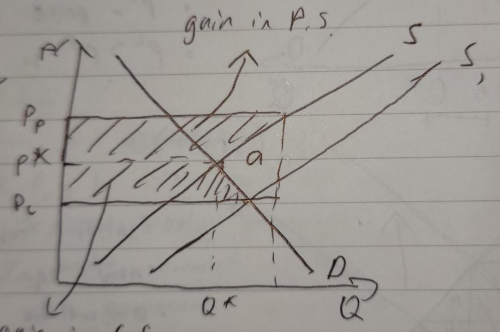
a = dead weight loss (DWL) due to overproduction
supply curve shifts (S → S1) because of one of the non-price determinants of supply (subsidies)
S1 = S + subsidy
2.8 - Market Failures
externalities are market failures, both positive and negative
Positive externality of consumption
goods that when consumed, both the consumer and third parties benefit from it (ex: healthcare)

MSC - marginal social cost
MPB - marginal private benefit
MSB - marginal social benefit
in a free market, people would consume where MPB=MSC (Q1, P1)
(Q*, P*) where MSB=MSC is the socially optimal level (potential welfare gain) because from Q1-Q*, MSB>MSC
if MPB shifts from Q1-Q* (toward MSB), then the welfare loss is gained (potential welfare gain = welfare loss)
underallocation of resources to this market (underproduction)
Merit Goods
goods that are beneficial to consumers but people do not consume enough
people underestimate/ignore potential benefits, caused by imperfect access to information
causes the demand to be lower than it should be
examples: healthcare, education
Government “fix”to positive externality of consumption
subsidies/direct provision
shifts the MSC curve downwards
new socially efficient level at Q* but at a lower price (P2)
P2 < P1 < P*
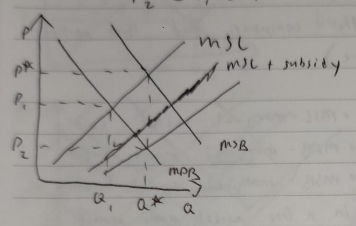
improving information (merit goods)
legislation: government passing laws that force citizens to consume the good
Positive externality of production
production of a good creates external benefits for third parties
ex: human capital: training employees
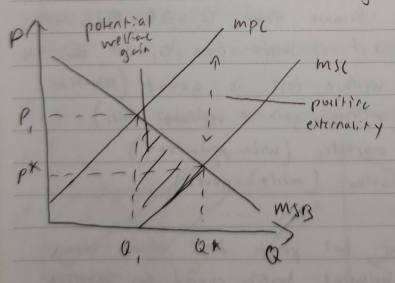
MPC - marginal private cost
produces where MPC=MSB, where Q1 is located (Q1 < Q*)
if production increases to Q*, there is a welfare gain (welfare loss turned into welfare gain)
underallocation of resources → market failure, allocative inefficiency
Government “fix” to positive externality of production
subsidies
causes MPC to be shifted downwards
full subsidy causes MPC=MSC when shifted
direct provision
high cost
offering training through the state for firms causes MPC=MSC
Negative externality of consumption
consumption causes adverse effects to third parties
ex: second hand smoking
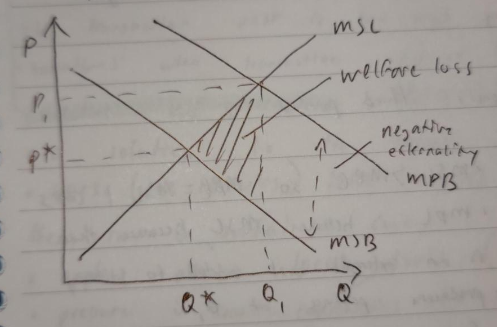 in a free market, people maximize their private utility so they consume at MPB=MSC
in a free market, people maximize their private utility so they consume at MPB=MSCthere is a welfare loss as MSC>MSB from Q*-Q1
overconsumption of goods
too many resources allocated
Demerit Goods
goods that are harmful to the consumer but people still consume either because they are unaware of or ignore the potential harm
caused by imperfect information
demand is higher than it should be
creates negative externalities when consumed
example: cigarettes
Government “fix” to negative externality of consumption
indirect taxes
taxes reduce consumption
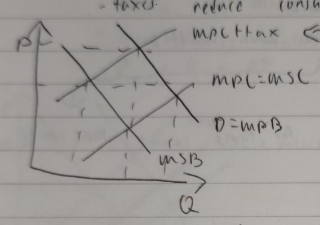
legislation/regulation
making laws against the overconsumption of demerit goods
education/raising awareness
Negative externality of production
production of a good negatively impacts third parties
example: fumes from a factory
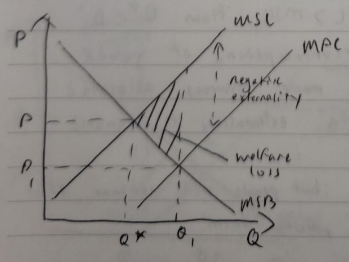
MSC<MPC so MPC=MSC+costs
MPC is below MSC, because there is an external cost added to society
producers produce at Q1
from Q1-Q*, MSC>MSB
welfare loss → market failure
Common Pool Resources
rivalrous and non-excludable (linked to negative externalities)
rivalrous: if one person uses, others cannot at the same level of utility
non-excluable: very difficult to exclude people/groups of people from using
typically natural resources
examples: fishing grounds, forests, atmosphere, etc.
Government “fix” to negative externality of production
international agreements
tradable permits
carbon taxes
legislations/regulations
subsidies